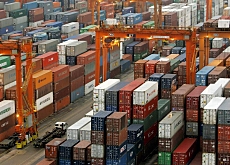
containers send home news of long journey

Researchers at IBM's Zurich laboratory are busy developing a real-time tracking system for shipping containers, which should improve security.
Known as Trec, or Tamper Resistant Embedded Controller, it could become the cornerstone of the company’s global surveillance programme.
IBM’s Secure Trade Lane responds to the need for data on shipments in the transport industry amid heightened security fears. According to the company, the logistics industry is fragmented and cannot track shipments along the entire supply chain.
More than 80 per cent of world trade travels aboard ships in containers, but only one in 50 containers is ever checked.
To answer these security concerns, researchers at the lab in the suburb of Rüschlikon have been trying to put together a package that allows officials and shippers to track the contents of a container at any time.
“We developed the trade lane concept in Zurich,” programme
leader Stefan Reidy told swissinfo. “In the beginning security was the main issue and it opened doors with customers who are looking for more oversight of their global supply chains.”
After defining the concept, which involves monitoring cargo and making the information available to users at any point, the researchers focused on the key element: the embedded controller.
Resistant
While the Trec uses elements that can be found on the market today, it needed to be resistant to the elements and survive regular rough treatment.
It is supposed to record events
involving the container, such as environmental changes, door opening or location.
“The core of the controller is a smart card,” explained Reidy. “The real difficulty was combining all the elements and making sure they could run on low power for three years.”
That IBM’s European research centre is working on such a system may come as a surprise. The Zurich laboratory is better known for the feats of scientists in the 1980s, when they received Nobel Prizes in physics two years running.
But this time the project is part of what the company calls “on demand innovation services”. Reidy said scientists at IBM were previously
churning out 3,500 patents annually, but not always responding to customer demand. By linking the researchers and marketing specialists, the firm hopes to focus more on customer realities.
Supply chain specialists
The trade lane is aimed first and foremost at logistics specialists.
“Containers are independent of the companies who actually transport them, so it makes more sense to work with people who organise the supply chain from one end to the other,” Reidy said.
Security concerns mean that logistics companies and shippers are under increased pressure from governments to provide safe and
dependable cargo transport.
“Companies know they have to do something,” Reidy said. “There’s definitely a willingness to answer those concerns, but they want solutions that make sense.”
The biggest concern is that governments may want impose certain types of technology and not necessarily IBM’s. Rival General Electric has begun testing its own system and others have been experimenting with radio frequency identification tags to monitor containers.
But Reidy says this technology has drawbacks, including a lack of a standard.
“You would have a different type of
tag for each system, meaning you would need special infrastructure at each monitoring point.”
Cost also remains a thorny issue. IBM will not reveal the cost of its system, although it says this in part because it is still in the experimental stage.
The company is asking its potential customers to focus instead on the gains they could make by implementing this type of system.
Possible savings
Reidy reckons a conservative estimate of the savings on logistics costs alone could be two to three per cent.
Other savings could be made on
stock and inventory costs.
Insurance companies might also find the system a very effective means in helping them figure out cases of losses and theft.
The trick is now to convince logistics companies – even if they only represent 40 per cent of worldwide shipping – to take the plunge. But Reidy is confident the market can be cracked.
“If we can get the big customers to sign up, the others will sit up and take notice.”
swissinfo, Scott Capper
Researchers at IBM Zurich were awarded the Nobel Prize in physics in 1986 and 1987.
Gerd Binnig and Heinrich Rohrer shared the prize in 1986 for their development of the scanning tunnelling microscope.
J. Georg Bednorz and K. Alex Müller were rewarded a year later for their groundbreaking work on superconductivity in ceramic materials.
IBM has maintained a research laboratory in Switzerland since 1956. It has been located in Rüschlikon near Zurich since 1962.
The laboratory employs around 300 people, including visiting scientists, of more than 20 nationalities.
Besides cooperating with other IBM labs around the world, the centre is also involved in joint projects with universities throughout Europe and with governmental and private research programmes.

In compliance with the JTI standards
More: SWI swissinfo.ch certified by the Journalism Trust Initiative





























You can find an overview of ongoing debates with our journalists here . Please join us!
If you want to start a conversation about a topic raised in this article or want to report factual errors, email us at english@swissinfo.ch.